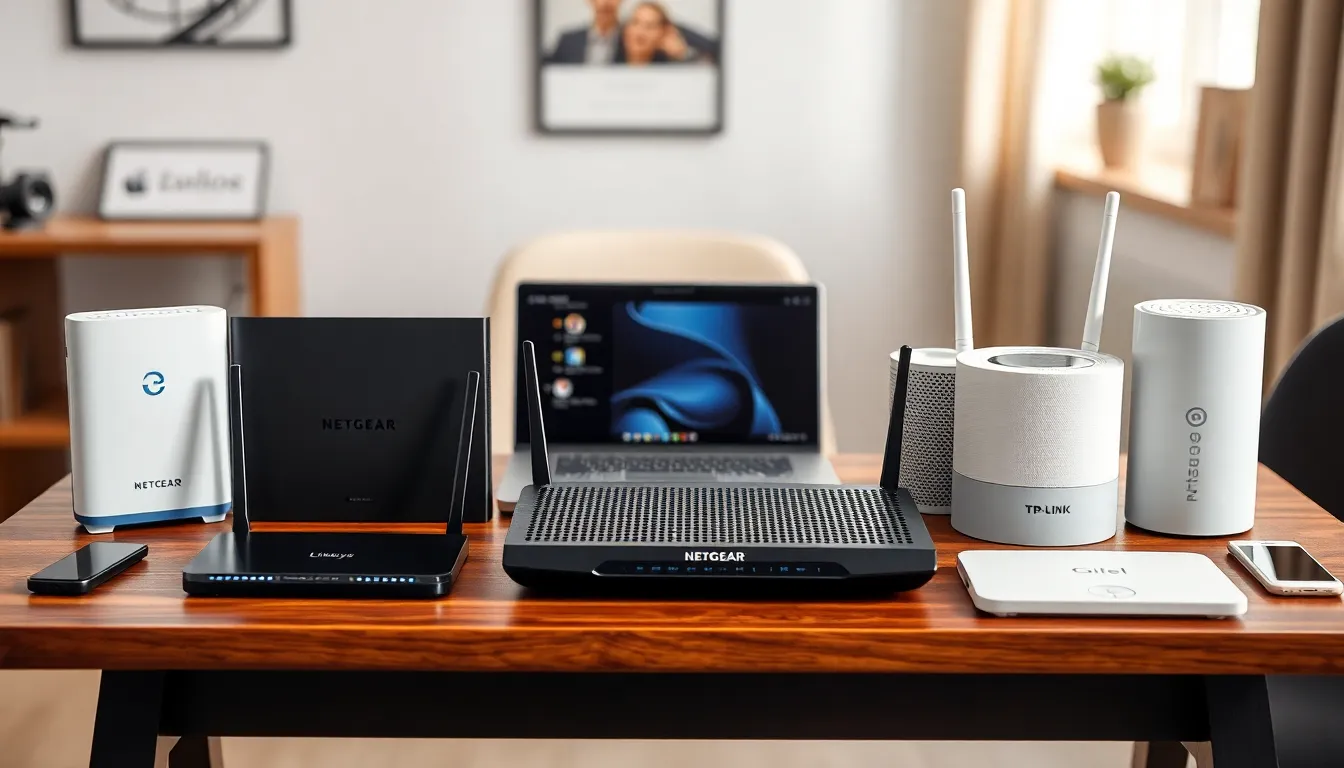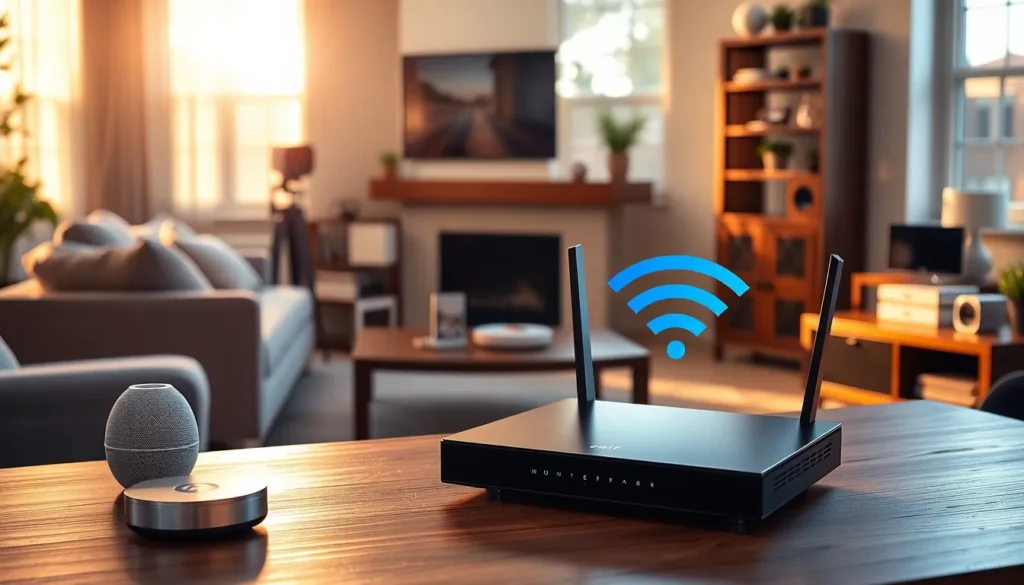In a world where buffering feels like a crime against humanity, the home networking device market is booming faster than a cat video going viral. With everyone streaming, gaming, and video chatting, the need for reliable, high-speed connections has never been more crucial. It’s not just about having Wi-Fi; it’s about having Wi-Fi that doesn’t make you want to throw your router out the window.
Table of Contents
ToggleOverview of Home Networking Device Market
The home networking device market experiences significant growth due to the rising demand for seamless connectivity. Increasing online activities such as streaming and gaming necessitate reliable devices that support high-speed internet. Market analysts project a steady annual growth rate, reflecting consumers’ eagerness to enhance their digital experiences at home.
Wi-Fi routers, extenders, and mesh systems dominate the market, offering improved coverage and speed. Consumers prioritize devices that support multiple connections, allowing everyone in the household to enjoy uninterrupted service. The trend toward smart home integration further fuels the demand, as users seek to connect various smart devices efficiently.
Security features also impact purchasing decisions. Many buyers look for devices equipped with advanced security protocols to protect personal data and privacy. Options like network firewalls and encryption methods significantly enhance device appeal.
Manufacturers respond to these market trends by introducing innovative products. Automation capabilities and user-friendly interfaces become essential features in new models. Enhancements in technology, such as Wi-Fi 6, ensure faster, more reliable connections for multiple devices.
Subscription-based services linked to networking equipment contribute to market expansion, as these services offer advanced features and continuous updates. As the market dynamics evolve, affordability continues to be a crucial factor influencing consumer choices, encouraging brands to provide competitive pricing alongside quality performance.
Overall, the home networking device market evolves rapidly, driven by consumers’ increasing connectivity expectations and technological advancements.
Key Players in the Home Networking Device Market

The home networking device market features several key players contributing to its growth and innovation.
Major Brands and Their Offerings
Netgear, a leader in networking technologies, offers a wide range of routers and mesh systems tailored for high-speed performance. Linksys provides versatile products known for their easy setup and reliable connections, ideal for households with multiple devices. TP-Link focuses on delivering budget-friendly solutions without sacrificing quality, featuring robust security features. Asus stands out with its gaming-focused routers, designed for low latency and a seamless experience. These major brands consistently innovate to meet consumer demands for speed and connectivity.
Emerging Companies and Innovations
Startups like Eero, acquired by Amazon, revolutionize home networking with user-friendly mesh Wi-Fi systems that promote extensive coverage. Google Nest, another innovator, integrates smart home functionalities seamlessly with its Wi-Fi routers. Momentus Technologies focuses on enhancing security protocols, catering to user concerns about data safety. Additionally, Plume offers cloud-based management features that allow for easy network optimization. These emerging companies push traditional boundaries, pushing advancements in technology and user experience.
Current Trends Shaping the Market
The home networking device market is evolving rapidly, influenced by various consumer demands and technological advancements.
Rise of Smart Home Devices
Smart home devices are increasingly integrated into daily life, leading to higher demand for capable networking equipment. Products like smart speakers, security cameras, and thermostats require reliable connections to function efficiently. Manufacturers focus on creating devices that support IoT ecosystems, ensuring smooth communication between devices. User-friendly interfaces improve consumer adoption, while compatibility with popular smart home platforms is essential. Industry leaders are continually launching systems optimized for seamless integration, attracting customers seeking enhanced living experiences. As a result, significant sales growth stems from home automation trends, propelling the network device market.
Increased Demand for High-Speed Internet
A surge in online activities has driven a substantial demand for high-speed internet. Households now require robust connectivity for streaming, gaming, and remote work. Many consumers are upgrading to Wi-Fi 6 technology, which supports faster speeds and multiple connections simultaneously. The shift toward cloud-based services, including video conferencing and online gaming, intensifies the need for reliable network performance. Internet Service Providers (ISPs) also play a critical role by promoting upgraded packages catering to increasing bandwidth requirements. Enhanced performance concerns lead consumers to invest in higher-quality networking devices that ensure uninterrupted access to the internet.
Challenges Facing the Home Networking Device Market
Several key challenges hinder growth in the home networking device market, impacting both consumers and manufacturers.
Security Concerns
Security concerns dominate the home networking landscape. Many users express anxiety about the vulnerability of their devices to cyber threats. Data breaches can lead to identity theft and privacy violations, prompting buyers to seek devices equipped with advanced security features. Manufacturers need to prioritize strong encryption methods and multi-factor authentication. Market participants often face scrutiny regarding their commitment to regular software updates, essential for mitigating potential security risks. Consumer trust hinges on seeing tangible efforts in enhancing device safety.
Compatibility Issues
Compatibility issues present another major challenge. Consumers frequently strive to connect various smart devices across different brands, often encountering obstacles. Some networking devices may not seamlessly integrate with all smart home products, limiting user experience. Ensuring compatibility with multiple protocols and standards is crucial for manufacturers. Many buyers prefer devices that work effortlessly with existing equipment and platforms. Results indicate that a lack of integration can deter potential customers from choosing certain brands, making interoperability a priority for market players.
Future Prospects of the Home Networking Device Market
The home networking device market shows promising growth as consumer connectivity needs evolve. Analysts predict substantial increases in market revenue due to the surge in smart home technology adoption and rising demand for high-speed internet.
Predictions for Market Growth
Market analysts expect the home networking device market to reach approximately $20 billion by 2025, driven by the adoption of Wi-Fi 6 and smart home devices. Growth rates of about 10% annually indicate strong consumer interest in robust connectivity solutions. Urban areas exhibit higher demand, as multiple smart devices often require seamless integration. Remote work, online learning, and digital entertainment contribute significantly to overall market expansion.
Innovations on the Horizon
Innovations are on the way in the home networking device market, with manufacturers focusing on performance and user experience. Advanced mesh systems promise enhanced coverage and reliability. AI-driven optimization for bandwidth allocation is gaining traction, ensuring users experience efficient connectivity. Security enhancements, including automated firmware updates and advanced encryption protocols, address growing consumer concerns about data safety. Enhanced interoperability features will simplify connections between various smart home devices, streamlining user experiences.
The home networking device market is poised for remarkable growth as consumer demands for high-speed connectivity continue to rise. With the increasing integration of smart home devices and the adoption of advanced technologies like Wi-Fi 6, manufacturers are innovating to meet the evolving needs of users.
As the landscape becomes more competitive, security features and compatibility will remain critical factors in purchasing decisions. Brands that prioritize these aspects while offering user-friendly solutions are likely to thrive.
With projections estimating significant market revenue increases by 2025, the future of home networking devices looks bright, driven by ongoing advancements and a commitment to enhancing user experiences.








